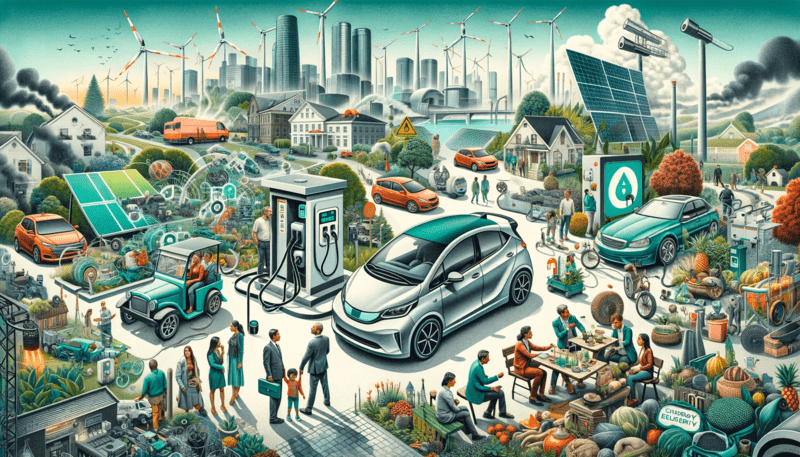TB872: Culturally feasible change
Note: this is a post reflecting on one of the modules of my MSc in Systems Thinking in Practice. You can see all of the related posts in this category.

One of the examples given about the difference between systematic feasibility and cultural feasibility in the context of change is around electric vehicles (EVs). This is of particular interest to me, as less than two months ago I took delivery of a Polestar 2, an EV that I’m leasing through my business.
By way of context, I thought long and hard about this, as it was an upgrade to a much-loved 10 year old Volvo V60 that did over 700 miles on a tank of diesel. It was getting to the age where repairs cost quite a bit, but it was still a wonderful car that could get us to the in-laws in Devon and back on a single tank.
In fact, I did the maths and worked out that the ’embodied emissions’ of manufacturing an EV such as the Polestar 2 didn’t actually make the switch worthwhile over the two-year leasing period. However, there are other things at play. One of these is the perception that you are eco-conscious, of walking the talk. Owning an older diesel car just doesn’t seem as environmentally-friendly as driving an EV. This is an issue around cultural feasibility, as the pendulum swings against polluting cars. See my previous post reflecting on the ‘ripples’ caused by mapping this against systematic change over time.
Another issue, which can’t be discounted, is what is usually called in the UK “keeping up with the Joneses”. In other words, the reputational benefits of having a new car.
Over and above these individual personal decision, however, are some wider issues. For example, as a business owner, the government provides incentives towards EVs in the form of lower ‘Benefit in Kind‘ (BIK) tax payments. This means that EVs become a ‘no brainer’ compared to their more (tailpipe) polluting counterparts.
Other considerations around systematic feasibility include:
- Infrastructure readiness: the availability of charging stations, along with the ability of power grids to support widespread EV charging. Given that EVs tend to be heavier than cars with internal combustion engines (ICE) due to their batteries, there’s also the the overall readiness of existing transportation systems to consider.
- Technological advancements: this includes the development and availability of efficient battery technology, the range of electric vehicles (range anxiety is real when you get a new EV!), as well as the integration of renewable energy sources into the mix in terms of electricity generation.
- Economic factors: it’s usually cheaper to charge EVs at home, but we’ve ended up in a situation where we can’t do this. Interestingly, one of the new council charging stations appears to be, at least temporarily, free of charge. Over and above that, though, are the costs associated with purchasing and maintaining EVs, incentives for buyers/leasers (as discussed above), and the economic viability of transitioning from ICE vehicles to EVs.
On the other hand, when it comes to cultural feasibility (the acceptance and adoption of EVs within a particular social or cultural context) we need to consider:
- Consumer attitudes & behaviours: people don’t make decisions in a vacuum. We were tipped over the edge of leasing an EV after a neighbour made the leap and didn’t seem to have many issues. This aspect is also influenced by their beliefs, values, and perceptions about environmental issues, technology, and change. For example, I’m always up for being a (relatively) early adopter and have strong opinions about fairness, social justice, and the environment.
- Social norms & traditions: it’s interesting to see that Scandanavian countries, which tend to have a more egalitarian culture, are leading the way on EV adoption. Ingrained practices and traditions, like car ownership patterns, commuting behaviors, and perceptions about new technologies, impact the adoption of EVs. Some say that people in this day and age don’t need a car, but we do actually need two in order to get our kids to sporting activities in semi-rural Northumberland. The public transport infrastructure just isn’t there.
- Political/policy environment: as we’re witnessing as the Conservative Party shapes up to fight the next general election, these kinds of issues can be ‘weaponised’. See, for example, the drama around the London ULEZ. Support or resistance from political entities (not just governments but think tanks, etc.), policy frameworks, and regulatory bodies that can facilitate or hinder the adoption of EVs.
It’s interesting to think of systemic vs cultural issues using this lens, particularly given that we’re still new to EVs. Any time you do something which is not culturally mainstream, it seems you get a barrage of questions or excuses why others don’t do similarly.
For example, 20 years ago during our first year of marriage, and while we were doing our teacher training, my wife and I chose not to have a TV (we still watched films on a computer). Lots of the questions that people asked about that were similar in nature to the questions I get about EVs. They’re largely about anxiety and fitting in with expected cultural norms.
Image: DALL-E 3

